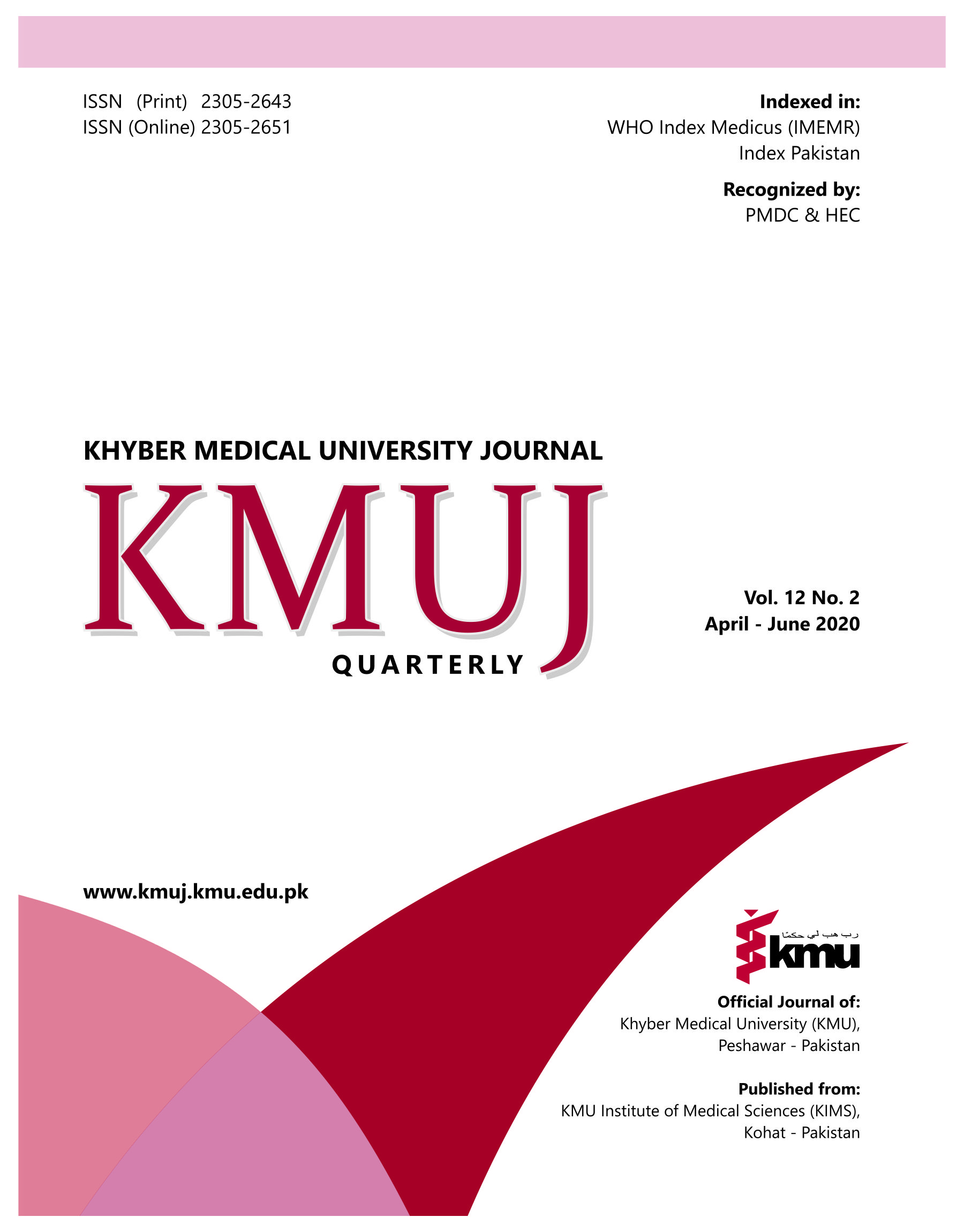CAREER MOTIVATION AMONG STUDENTS OF DIFFERENT UNDERGRADUATE MEDICAL INSTITUTES: A REVIEW OF EXISTING PERCEPTIONS
Main Article Content
Abstract
OBJECTIVES: To explore future career prospects among undergraduate medical students from different institutes and to review existing perceptions among them.
METHODS: This descriptive cross-sectional study was conducted in six different medical colleges of Pakistan from January 2017 to June 2017 including two public and four private sector medical colleges. A structured and pre-validated questionnaire was used to collect the data. Data was analyzed using SPSS 21 and Epi info 7.
RESULTS: Out of 164 students, 75 (45.8%) were males and 89 (54.2%) were females. The public and private sector students distribution was 72 (43.9%) and 92 (56.10%) respectively. Mean age was 22.63±1.99 years. Out of 143 (87.2%) students responding to do specialization, 88 (53.7%) wanted to go abroad while 55 (33.5%) were interested in local training. Upon making rural work obligatory, 111 (68%) showed willingness to work with maximum (n=57/111; 51.35%) wanted to serve the under-privileged community. Majority (n=139; 85%) of the students had no intention to change the profession and maximum (n=55; 33.54%) opted for the field of Medicine as specialization. In factors, own decision by students and gender-based impact on specialization in both sectors had a significant relationship with different motivational aspects (p-value = <0.01).
CONCLUSION: The study revealed that majority of the students wanted to do specialization and preferred going abroad for specialization than opting for local training. About two-third of students were willing to join rural setting, if made obligatory and almost all wanted to be in medical profession throughout the life.
Article Details
Work published in KMUJ is licensed under a
Creative Commons Attribution 4.0 License
Authors are permitted and encouraged to post their work online (e.g., in institutional repositories or on their website) prior to and during the submission process, as it can lead to productive exchanges, as well as earlier and greater citation of published work.
(e.g., in institutional repositories or on their website) prior to and during the submission process, as it can lead to productive exchanges, as well as earlier and greater citation of published work.
References
World Population Review. World Population Prospects (2017 Revision) - United Nations population estimates and projections. [Accessed on: March 30, 2019]. Available from URL: http://worldpopulationreview.com/countries/pakistan-population/.
Pakistan Bureau of Statistic. Provisional province wise population by sex and rural/urban census - 2017 Pakistan. [Accessed on: March 30, 2019]. Available from URL: http://www.pbs.gov.pk/sites/default/files//DISTRICT_WISE_CENSUS_RESULTS_CENSUS_2017.pdf.
Pakistan Medical and Dental Council (PM&DC). Recognized medical colleges in Pakistan. [Accessed on: March 30, 2019]. Available from URL: http://www.pmdc.org.pk/AboutUs/RecognizedMedicalDentalColleges/tabid/109/Default.aspx.
Global health workforce alliance. Pakistan: establishing an HRH coordination process. [Accessed on: March 30, 2019]. Available from URL: https://www.who.int/workforcealliance/knowledge/resources/CCF_CaseStudy_Pakistan.pdf.
Aly Z, Taj F. Why Pakistani medical graduates must remain free to emigrate. PLoS Med 2008;5(1):e2. DOI: 10.1371/journal.pmed.0050002.
Sierles FS, Taylor MA. Decline of U.S. medical student career choice of psychiatry and what to do about it. Am J Psychiatry 1995;152(10):1416-26. DOI: 10.1176/ajp.152.10.1416.
Edmund NO, Kenechi AU, Uchenna CA, Ntat CI, Benedict NA, Ngozi E. Specialty preferences among final year medical students in medical schools of southeast Nigeria: need for career guidance. BMC Med Educ 2016;16:259(2016). DOI: 10.1186/s12909-016-0781-3.
Baharvand M, Moghaddam EJ, Pouretemad H, Alavi K. Attitudes of Iranian Dental Students Toward Their Future Careers: An Exploratory Study. J Dent Educ 2011;75(11):1489-95.
Shahab F, Hussain H, Inayat A, Shahab A. Attitudes of medical students towards their career - perspective from Khyber-Pukhtunkhwa. J Pakistan Med Assoc 2013; 63(8):1017-20.
Biggs J. Postgraduate medical training in Pakistan: observations and recommendations. J Coll Physicians Surg Pak 2008;18(1):58-63.
Aslam M, Taj T, Mirza W, Ammar A, Muzaffar S, Kauten JR. Specialty choices of medical students and house officers in Karachi, Pakistan. East Mediterr Health J 2011;17(1):74-9. DOI: 10.26719/2011.17.1.74.
American Academy of Family Physicians (AAFP). Choosing a Medical Specialty. [Accessed on: May 13, 2018]. Available from URL: https://www.aafp.org/medical-school-residency/medical-school/specialty.html.
Diwan V, Minj C, Chhari N, De Costa A. Indian medical students in public and private sector medical schools: are motivations and career aspirations different? – Studies from Madhya Pradesh, India. BMC Med Educ 2013;13(127). DOI: 10.1186/1472-6920-13-127.
Malik N, Jan GuD, Niazi M, Aftab N, Bakhat S, Rashid T. Factors Affecting Career Choices of Newly Admitted and Graduating Medical Students. J Rawal Med Coll 2017;21(2):177-81.
Alam K, Safdar CA, Munir TA, Ghani Z. Teaching obstetrics and gynaecology to male undergraduate medical students: student's perception. J Ayub Med Coll Abbottabad 2014;26(4):539-42.
Alsubaie N, Aldhofaian HS, Alhuwaimel L, Ruxshan N, Alghamdi F, Shamia A, et al. Specialty Preferences and the Factors Influencing Them Among Pre-Clerkship Medical Students: The First Study from Alfaisal University-College of Medicine, Saudi Arabia. Cureus 2016;8(11):e894. DOI: 10.7759/cureus.894.
Boyle V, Shulruf B, Poole P. Influence of gender and other factors on medical student specialty interest. N Z Med J 2014;127(1402):78-87.
Stahn B, Harendza S. Role models play the greatest role - a qualitative study on reasons for choosing postgraduate training at a university hospital. GMS Z Med Ausbild 2014;31(4):1-15. DOI: 10.3205/zma000937.
Ray RA, Young L, Lindsay DB. The influences of background on beginning medical students’ perceptions of rural medical practice. BMC Medical Education 2015;15:58. DOI: 10.1186/s12909-015-0339-9.
Budhathoki SS, Zwanikken PA, Pokharel PK, Scherpbier AJ. Factors influencing medical students' motivation to practice in rural areas in low-income and middle-income countries: a systematic review. BMJ Open 2017;7(2):e013501. DOI: 10.1136/bmjopen-2016-013501.
Royston PJ, Mathieson K, Leafman J, Ojan-Sheehan O. Medical student characteristics predictive of intent for rural practice. Rural Remote Health 2012;12:2107.
Huntington I, Shrestha S, Reich NG, Hagopian A. Career intentions of medical students in the setting of Nepal's rapidly expanding private medical education system. Health Policy Plan 2012;27(5):417-28. DOI: 10.1093/heapol/czr052.
Larkins S, Michielsen K, Iputo J, Elsanousi S, Mammen M, Graves L, et al. Impact of selection strategies on representation of underserved populations and intention to practice: international findings. Med Educ 2015;49(1):60-72. DOI: 10.1111/medu.12518.
Puddey IB, Mercer A, Playford DE, Pougnault S, Riley GJ. Medical student selection criteria as predictors of intended rural practice following graduation. BMC Med Educ 2014;14:218. DOI: 10.1186/1472-6920-14-218.
